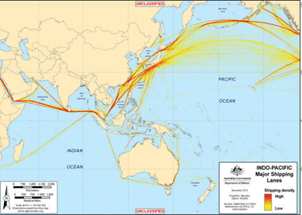Dr Cameron Hill, Foreign Affairs, Defence and Security Section
Key issue
Navigating the ‘Indo-Pacific’ century will require ongoing adjustments in policies, both foreign and domestic, that will allow Australia to take advantage of new rewards and prepare for new risks. Business and civil society, as well as government, will have important roles to play in constructing strengthened relationships across the region. |
The Gillard Government’s October 2012 Australia in the Asian Century White Paper played an important role in helping focus ongoing policy debates surrounding Australia’s regional engagement. The White Paper presented a framework for this engagement that spanned domestic and foreign policy reforms, as well as a range of actions across government and non-government (business, civil society) sectors.
While the Opposition criticised the White Paper as lacking ‘strategic vision’, it conceded that the document contained ‘laudable goals and aspirations’. Indeed, the Coalition has maintained that it will enhance Australia’s standing in the region by pursuing a foreign policy that is ‘more Jakarta, less Geneva’ and that this approach will see ‘new free trade agreements concluded, existing security relationships strengthened, and more people-to-people exchanges’.
‘Asian’, ‘Asia-Pacific’ or ‘Indo-Pacific’ century?
One of the most immediate questions raised by this debate is how Australia should conceptualise the emerging centres of power in the region and its place in these—are they best conceived of in terms of ‘East Asia’ (Northeast + Southeast Asia), the ‘Asia-Pacific’ (East Asia + Pacific + the US), or the ‘Indo-Pacific’ (the Asia-Pacific + Indian Ocean states)?
Many commentators and policy makers have now shifted to using the more expansive ‘Indo-Pacific’ definition, recognising that:
The Indian Ocean is now surpassing the Atlantic and Pacific oceans as the world’s busiest trade corridor. Rapid economic growth in South, Northeast and Southeast Asia is driving stronger economic links with the resource-rich Middle East and Africa. One-third of the world’s bulk cargo and around two-thirds of global oil shipments now pass through the Indian Ocean (Figure 1).
Figure 1: Shipping traffic in the Indo-Pacific

Source: Department of Defence
Rewards
The fact that Australia and its closest neighbours are positioned at the nexus of the Indo-Pacific offers well-documented opportunities.
According to the 2012 White Paper, the (re)coupling of the major centres of global population (China and India) and the major centres of global economic growth means that ‘Australian businesses and their employees can be big winners from the Asian century, with new and expanding opportunities for our miners, manufacturers, farmers and a broad range of service providers’.
…and risks
However, some analysts have argued that, despite growing middle class affluence, the strategic outlook in the Indo-Pacific may be more hazardous. They have also criticised both major parties for failing to adequately prepare Australia for a ‘less rosy Asia’.
Possible scenarios might involve making very hard choices about how to accommodate China’s growing power, managing intensified maritime and territorial conflicts that threaten vital shipping lanes, or dealing with a new Indonesian leadership that will, potentially, be more self-confident and less positively predisposed to Australia’s interests (see separate brief on Australia’s relationship with Indonesia).
Relationships
The White Paper nominated five priority regional relationships for Australia–China, Japan, India, Indonesia, and South Korea. In mid-2013, the Rudd Government released new Country Strategies aimed at providing a long term vision (to 2025) for each of these relationships.
Australia has also pursued a closer strategic relationship with Vietnam, a country which continues to feel the direct impact of China’s growing power in the region in the form of an intensified maritime and territorial dispute in the South China Sea. Myanmar has also been a focus, as this country attempts to re-engage with the West and the broader international community as part of its recent political and economic reforms.
Beyond these bilateral relationships, it has been argued that Australia needs to have a distinct strategy to guide our emerging relationship with the Association of Southeast Asian Nations (ASEAN) because it is this grouping that ‘is now widely acknowledged as a leader in developing broader regional planning and institution building’.
While highlighting the importance of government-to-government relationships, both Labor and the Coalition have also focused on building strengthened people-to-people links across the region. In the case of the Coalition, this has centred on a $100 million ‘new Colombo Plan’ which will provide financial support for young Australians to study in the region. Business has also been a focus, with renewed efforts by government and the private sector to develop an ‘Asia-capable’ workforce able to support Australia’s commercial engagement with a dynamic and ever-changing region.
Despite these new promises, neither Labor nor the Coalition has given a firm commitment regarding future resourcing for the Department of Foreign Affairs and Trade, funding for which is now at historic lows.
While the Coalition has committed to a review of Australia’s diplomatic resources, it is not clear whether it will support the White Paper’s (unfunded) commitment to increase Australia’s representation in the region through the establishment of new diplomatic missions in China, Indonesia, Thailand, and Mongolia.
Like all areas of public policy, Australia’s future regional engagement will involve important judgements and trade-offs. Given that the region did not feature prominently in the 2013 election campaign, the Government’s challenge will be to convey these judgements and trade-offs to the Australian public in a clear and frank manner, explaining both the long-term rewards and the risks.
Further reading
C Hill, ‘Australia in the Asian Century: regional security and foreign policy dimensions’, FlagPost weblog, 12 November 2012.
T Milner and S Wood, eds, Our place in the Asian Century: Southeast Asia as ‘the third way’, Asialink, University of Melbourne, Melbourne, November 2012.
R Medcalf, Pivoting the map: Australia’s Indo-Pacific system, Centre of Gravity series, 1, Strategic and Defence Studies Centre, Australian National University, Canberra, November 2012.
Australian Government, Australia in the Asian Century, White paper, Canberra, October 2012.
For copyright reasons some linked items are only available to members of Parliament.
© Commonwealth of Australia